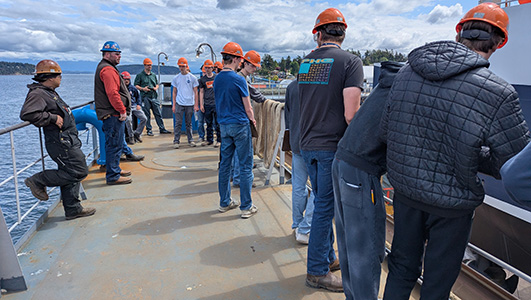||| FROM AMY SCARTON for WASHINGTON STATE FERRIES |||
2020 was certainly a challenging year, but in many ways it showed us all what’s really important in life. Our duty to ensure the safety of our passengers and crews while traveling the Salish Sea was more difficult than ever before. Despite the hardships caused by COVID-19, I witnessed resiliency and creative problem solving from our team here at Washington State Ferries (WSF).
This was also my last year as head of WSF. As many of you know, I am moving on to be the new Deputy Secretary of the Washington State Department of Transportation (WSDOT).
I felt it was fitting that our WSF Year in Review focuses on the progress we made in 2020 and the incredible work that went into protecting our fleet and passengers during an unprecedented time for us as a transportation agency.

I had the great honor of participating in a virtual ribbon cutting to open our brand new Mukilteo Multimodal Ferry Terminal.
COVID-19 Response
In March of 2020, as the COVID-19 pandemic started, we saw our ridership drop to 1960s levels. In addition to a dramatic overall decrease in ferry riders we saw a significant decrease in walk-on customers on routes that serve downtown Seattle and across the system. More people chose to drive on board our vessels. So, we adapted. We developed a COVID-19 Response Service Plan and changed from seasonal schedules to service based on four pillars: ridership, crew availability, funding, and vessels.
Our crews preserved during a national PPE shortage. Most of our office-based employees made the drastic change to full-time telework with very little notice. We learned new ways for our terminals to safely operate. And meanwhile, we made progress on key projects. We even opened the first new ferry terminal in 40 years!

We saw a decrease in riders over 2020.

All WSF customers and staff are required to wear masks.

Notices about mask wearing requirements at our toll booths help keep our employees and customers safe. 
Reliable service
In 2020 the availability of our ferries became one of the focuses of our COVID-19 Response Service Plan. Since critical maintenance was delayed on many of our vessels due to Gov. Inslee’s Stay Home, Stay Healthy initiative, we could not increase service if we didn’t have the vessels to support it.
Despite the challenges posed by COVID-19, the dedicated crews and team at our Eagle Harbor Maintenance Facility continued working hard to make sure our fleet was operational. Our Eagle Harbor teams respond to critical vessel and terminal repairs and was responsible for installing sneeze guards at every toll booth in our ferry system. In order to reopen, each job site had to have an approved comprehensive COVID-19 exposure control plan demonstrating how all on site staff will adhere to a list of 30 safety protocols.
Reliable vessels, terminals, and a growing workforce are essential to keep our system running. The 2040 Long Range Plan indicates we will need 16 new vessels by 2040 just to keep the services we have in place today. I look forward to advocating for critical investments in our ferry system in my new role.

Welders from our Eagle Harbor Maintenance Facility working on the transfer span bridge seat at Southworth terminal.

The new shoreside Marine Evacuation System (MES) allows our crew members to train for vessel evacuations without disrupting service.

Our Eagle Harbor employees worked hard to deploy sneeze guards at every toll booth in our WSF system. Sneeze guards help decrease contact between our employees and customers.
Workforce recruitment, training, and succession planning
Much like our vessels, crew availability was another important focus of our COVID-19 response plan. More than 100 of our crewmembers are considered “high-risk” and spent time working remotely for health and safety reasons. In a “normal” year we begin training new crew members for the busy summer season in the spring. We had to delay training efforts which led to a shortage of new crew members able to operate our vessels. Without enough crew to fill all the Coast Guard-mandated slots on our vessels, maintaining service was a significant challenge.
Before a new employee can serve as a crewmember on one of our vessels, they must go through weeks of intensive training, which includes firefighting, personal safety and survival, classroom time and job duty familiarization out in our fleet. Even though it was a challenge to train our employees while maintaining the proper COVID-19 safety protocols, our training department was able to begin conducting face-to-face new deck employee orientations in June.

Training new employees in a socially distanced, COVID-19 conscious way aboard the Elwha.

New WSF employees go through fire fighting training.

New employees pose for a socially distanced group shot aboard the Elwha.
Mukilteo Multimodal Ferry Terminal opened in December

Our crews practiced landing at the brand new Mukilteo Multimodal Ferry Terminal ahead of the first sailing.
On Dec. 29, 2020 we opened the first new ferry terminal in 40 years. Because we couldn’t celebrate the terminal opening in person, we released a virtual grand opening video highlighting many of the unique features of the terminal.
The Mukilteo Multimodal Ferry Terminal honors the tribal history of the land, the site of the 1855 Point Elliott Treaty signing. The passenger building, designed in the form a Coast Salish longhouse, features a large gathering hall with sweeping views of the water and a comfortable place for people to work, relax and stretch their legs while waiting for the ferry. The new terminal was also built to Leadership in Energy and Environmental Design (LEED) Gold standards for its efficient design. The site has many resource-saving features – solar panels, rainwater harvesting, natural ventilation, radiant floor heat, stormwater treatment, rain gardens and more.

New toll plaza and toll booths with Coast Salish artwork.

An inside look at the new passenger building.
Greening the fleet
We made progress on our Ferry System Electrification project in 2020. Our Jumbo Mark II conversion project received a big boost in 2020 with a $1.5 million grant award. Converting our largest vessels to a hybrid electric model will reduce fuel consumption by 5 million gallons per year, reduce maintenance costs, and save roughly $60 million in the overall lifecycle of these hard-working ferries.
I’m very glad that Gov. Jay Inslee’s budget proposal provides strong support for ferry system electrification, including funding requests to build a second new Hybrid Electric Olympic Class ferry, convert a second Jumbo Mark II Class vessel to hybrid electric and build three terminal charging stations. I look forward to working with legislators in my new role as they consider these requests and many other important transportation infrastructure investments.

Current plans for new Hybrid Electric Olympic Class vessels include improvements requested by crew and customers.

Plans for charging hybrid electric vessels at our current terminals include long “shore charging arms.”

An aerial shot of the Seattle Ferry Terminal at Colman Dock. In 2021 WSF will continue to work on building this new facility that serves the Seattle/Bainbridge and Seattle/Bremerton routes.
Looking ahead to 2021
As we move into 2021 we’ll continue to closely monitor COVID-19 data and restore service while taking our four pillars of service and Gov. Inslee’s Healthy Washington – Roadmap to Recovery into consideration. We’ll also be revisiting our 2040 Long Range Plan and recalibrating since this unpredictable year had an impact on our short and long term goals. As we plan for the future we’ll continue to focus on the WSDOT Strategic Plan priorities;
- Workforce Development
- Inclusion
- Practical Solutions
I’m looking forward to what lies ahead for WSF in 2021. It has been an honor to work with such adaptive and innovative colleagues for the past four years. I feel confident leaving such a great team under Assistant Secretary Patty Rubstello’s leadership.
As always, if you want to receive updates about WSF throughout the year, be sure to follow us on Twitter and find us on Facebook. You can also receive the latest news each week our Weekly Update.
**If you are reading theOrcasonian for free, thank your fellow islanders. If you would like to support theOrcasonian CLICK HERE to set your modestly-priced, voluntary subscription. Otherwise, no worries; we’re happy to share with you.**








